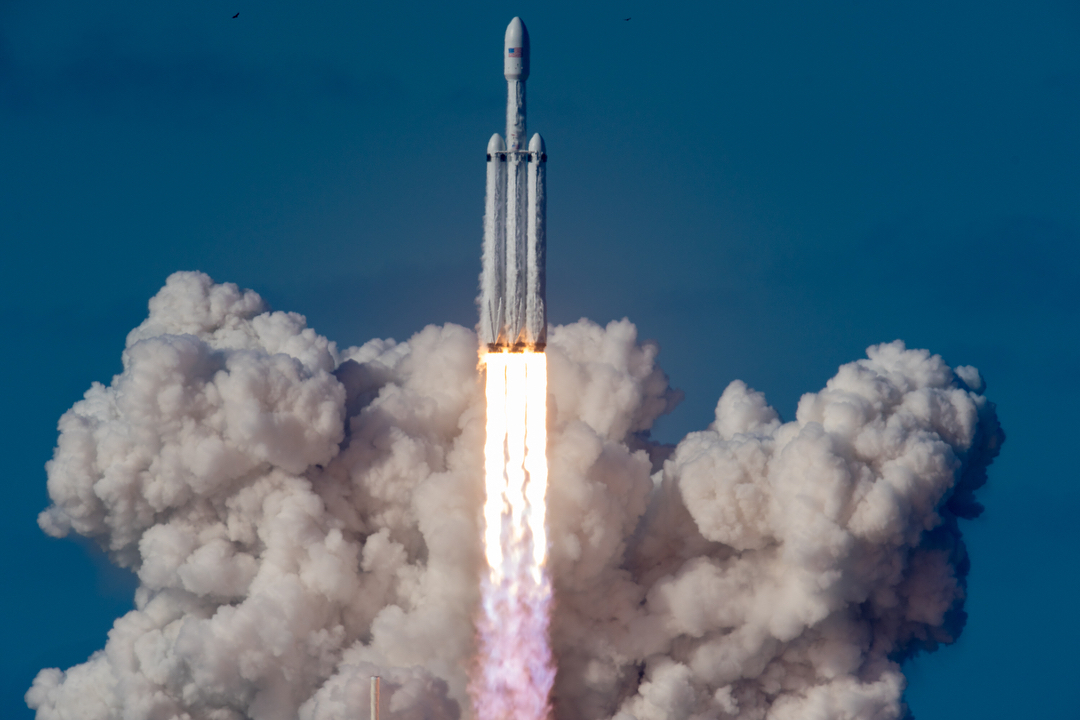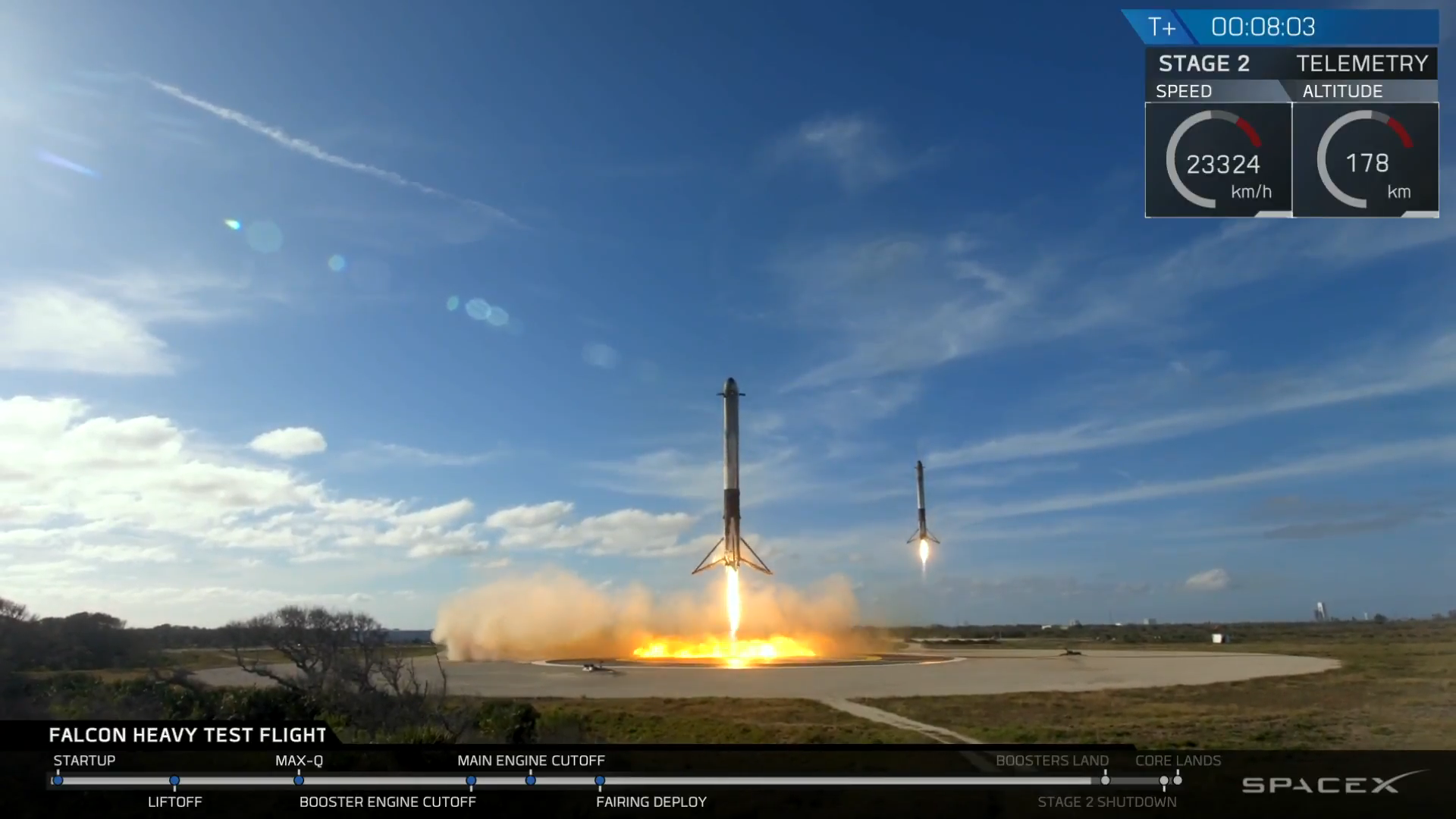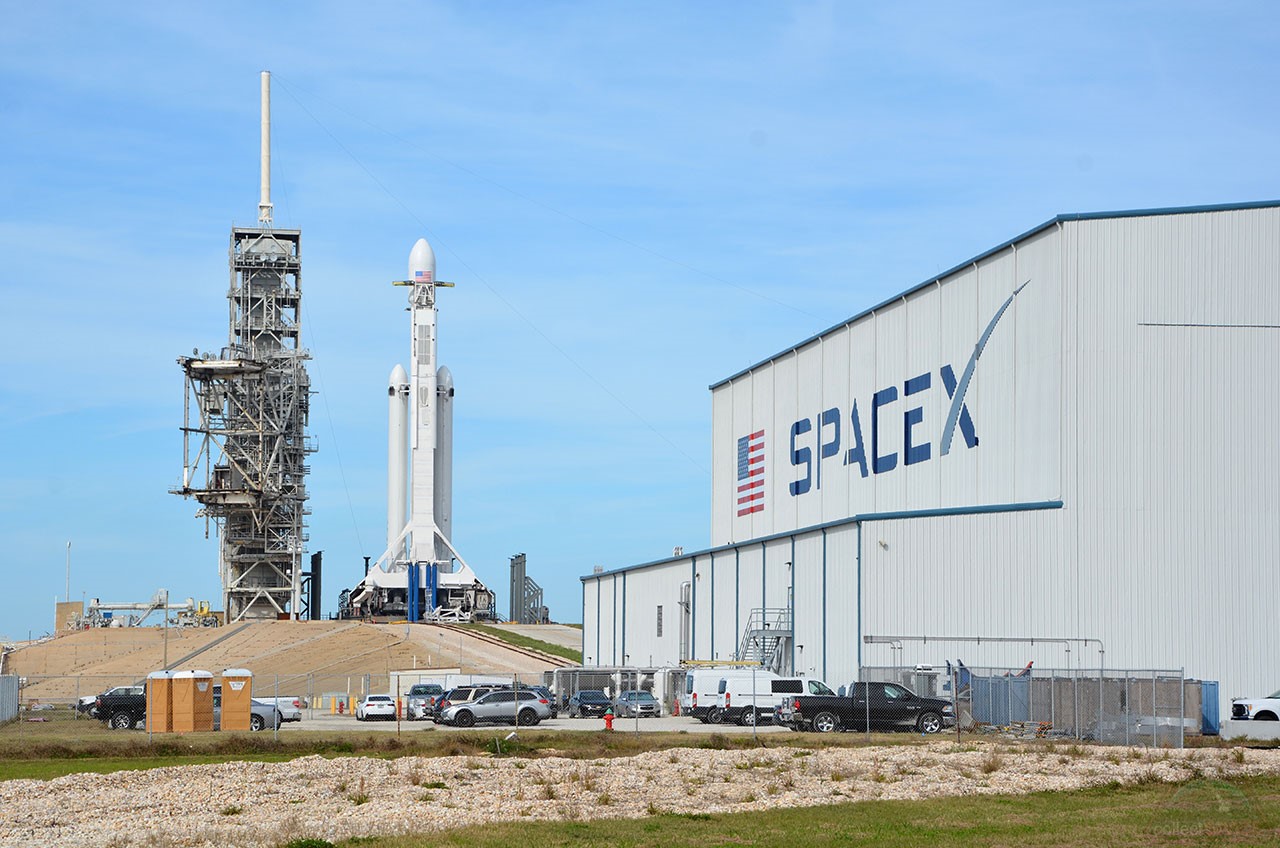Success! SpaceX Launches Falcon Heavy Rocket on Historic Maiden Voyage
CAPE CANAVERAL, Fla. — The first Falcon Heavy rocket built by the private spaceflight company SpaceX soared on its maiden voyage today (Feb. 6) — a historic test flight that also sent a car toward Mars and included two confirmed booster landings.
Billed as the world's most powerful booster since NASA's Saturn V, the Falcon Heavy rocket lifted off from Launch Pad 39A here at Kennedy Space Center (KSC) — the same site used by NASA's Apollo moon missions and space shuttles — at 3:45 p.m. EST (2045GMT) after more than two hours of delays due to upper level winds.
"I'm really excited about today," SpaceX CEO Elon Musk told reporters after the launch. "I'm really proud of the SpaceX team. They've done an incredible job of creating the most advanced rocket in the world, and the biggest rocket in the world."
Standing 23 stories tall, the Falcon Heavy rocket is SpaceX's largest rocket yet. Its first stage is powered by three core boosters based on SpaceX's Falcon 9 rockets, with 27 engines (nine per booster) firing in unison to produce about 5 million lbs. of thrust (22,819 kilonewtons) at liftoff. While SpaceX hoped all three boosters would return to Earth and land, the center core missed its mark - a minor hiccup in an otherwise successful launch, Musk said. [SpaceX's 1st Falcon Heavy Rocket Test Flight in Pictures]
The rocket will eventually launch payloads of up to 141,000 lbs. (64,000 kilograms) into orbit. That's about twice the payload capacity of its nearest competitor, the Delta IV Heavy, built by United Launch Alliance.
"This is a test flight," Musk said yesterday (Feb. 5). "If the test flight works, I think we'd be ready to put satellites on the next mission." That mission, Musk added, could occur within the next three to six months.
A car in space, and reused rockets
SpaceX's Falcon Heavy test flight was arguably one of the most anticipated rocket launches in years, with an estimated 100,000 spectators expected to visit Florida's Space Coast to witness the event. Among those in attendance was famed Apollo 11 astronaut Buzz Aldrin, who watched as the Falcon Heavy launched from the same pad he used to fly to the moon in 1969.
Breaking space news, the latest updates on rocket launches, skywatching events and more!
Part of that allure is the mission's novelty: This Falcon Heavy is the first of its kind, a new breed of reusable monster rocket.
The two side boosters of the first stage have flown before. One launched the Thaicom 8 communications satellite in May 2016, and the other lofted a Dragon cargo ship for NASA in July 2016, according to SpaceX. The center core stage was completely new for the Falcon Heavy. [SpaceX's Falcon Heavy Rocket Explained (Infographic)]
In a sort of cosmic dance, the three first-stage core boosters returned to Earth much like SpaceX's Falcon 9 rockets have in the past. Two boosters touched down at SpaceX landing sites at Cape Canaveral Air Force Station near KSC. The third was scheduled to land on SpaceX's drone-ship landing pad "Of Course I Still Love You," stationed in the Atlantic Ocean.
Musk said the core stage hit the Atlantic Ocean at about 300 mph after two of three engines did not fire during the descent. The crash damaged the nearby drone ship, he added.
SpaceX has now successfully landed Falcon-family rockets 24 times — three on this mission alone. (The rocket family is named after another famously reusable spaceship, the fictional Millennium Falcon from "Star Wars," Musk has said.)
But perhaps the biggest draw of today's launch was the Falcon Heavy's unique payload: a Tesla Roadster riding atop the rocket's second stage.
Musk announced in December that the "midnight cherry red" convertible, which he owns, would be the first Falcon Heavy payload. Then, on Monday, he revealed another surprise: a spacesuit-clad mannequin called "Starman"(a reference to David Bowie's song "Starman") in the driver's seat, with its right hand on the wheel and left arm resting on the door.
About 28 minutes into today's test flight, the second stage carrying the Roadster shut down its engine, ending the main phase of the Falcon Heavy test flight. If all goes well, the second stage will coast for 6 hours through Earth's Van Allen belts, regions of extremely high radiation, and then restart its engine to send the Roadster and Starman toward Mars.
That maneuver will send the Roadster into orbit around the sun and, in turn, eventually carry the car and Starman about 248 million miles (400 million kilometers) from Earth.
"It will essentially be an Earth-Mars cycler," Musk said, adding that the orbit should bring the Roadster near Mars. There is an "extremely tiny" chance the car could hit the Red Planet, he added.
There are three cameras on the Roadster, Musk said, adding that they should capture "epic views" during the mission.
"I'm not worried about the car," Musk said. "It'll be fine."
A future for Falcon Heavy
When Musk first announced the Falcon Heavy in April 2011, he predicted that its first flight could occur by 2013. But that year came and went, followed by more, as SpaceX tackled the nuances of building a reusable heavy-lift rocket. Musk estimates SpaceX invested about $500 million of its own funds to develop the new rocket.
Now, with the first test flight in the books, SpaceX is ready to forge ahead with commercial satellite launches. Two missions are scheduled for 2018: the launch of the Arabsat 6A communications satellite, and the Space Test Program 2 mission for the U.S. Air Force, which also includes a solar-sail mission for The Planetary Society.
The Falcon Heavy's raw power, combined with its reusable design, represents a giant leap forward for SpaceX.
"This would be a major milestone in heavy lift," Scott Hubbard, editor of the peer-reviewed journal New Space and an adjunct professor of aeronautics and astronautics at Stanford University, told Space.com before the launch. "A successful test would really advance, in my view, the potential for planning commercially acquired launch services for deep space."
SpaceX aims to sell Falcon Heavy launches for about $90 million per flight. (The single-core Falcon 9 launches sell for $62 million per flight.) By reusing the Falcon Heavy boosters, the company hopes to drastically reduce the cost of heavy-lift space missions to near that of its Falcon 9 missions.
"If we are successful in this, it is game over for all other heavy-lift rockets," Musk said.
The Falcon Heavy is part of a growing list of SpaceX launch services and ongoing projects. The company already provides satellite launch services and Dragon cargo delivery missions for NASA using its Falcon 9 rockets.
SpaceX is also building a crewed version of the Dragon space capsule to ferry astronauts to the International Space Station for NASA, with the first flights scheduled for later this year.
Meanwhile, SpaceX is developing a launch system even larger than the Falcon Heavy, called the BFR (or Big Falcon Rocket). That booster, Musk has said, is designed to launch hundreds of people into space at one time and could be used to transport passengers around the world quickly for point-to-point travel.
Musk said he was thinking of the BFR on Monday while visiting the Falcon Heavy at the launchpad ahead of today's launch.
"I'm looking at Falcon Heavy, and I'm thinking, 'It's a bit small,'" he said.
Editor's note: This story was updated at 8 p.m. EST to include details about the Falcon Heavy core stage, which did not survive its landing attempt. The impact speed of the core booster has also been corrected to 300 mph.
Space.com senior writer Michael Wall contributed to this report from San Francisco. Email Tariq Malik at tmalik@space.com or follow him @tariqjmalik and Google+. Follow us @Spacedotcom, Facebook and Google+. Original article on Space.com.

Tariq is the award-winning Editor-in-Chief of Space.com and joined the team in 2001. He covers human spaceflight, as well as skywatching and entertainment. He became Space.com's Editor-in-Chief in 2019. Before joining Space.com, Tariq was a staff reporter for The Los Angeles Times covering education and city beats in La Habra, Fullerton and Huntington Beach. He's a recipient of the 2022 Harry Kolcum Award for excellence in space reporting and the 2025 Space Pioneer Award from the National Space Society. He is an Eagle Scout and Space Camp alum with journalism degrees from the USC and NYU. You can find Tariq at Space.com and as the co-host to the This Week In Space podcast on the TWiT network. To see his latest project, you can follow Tariq on Twitter @tariqjmalik.





